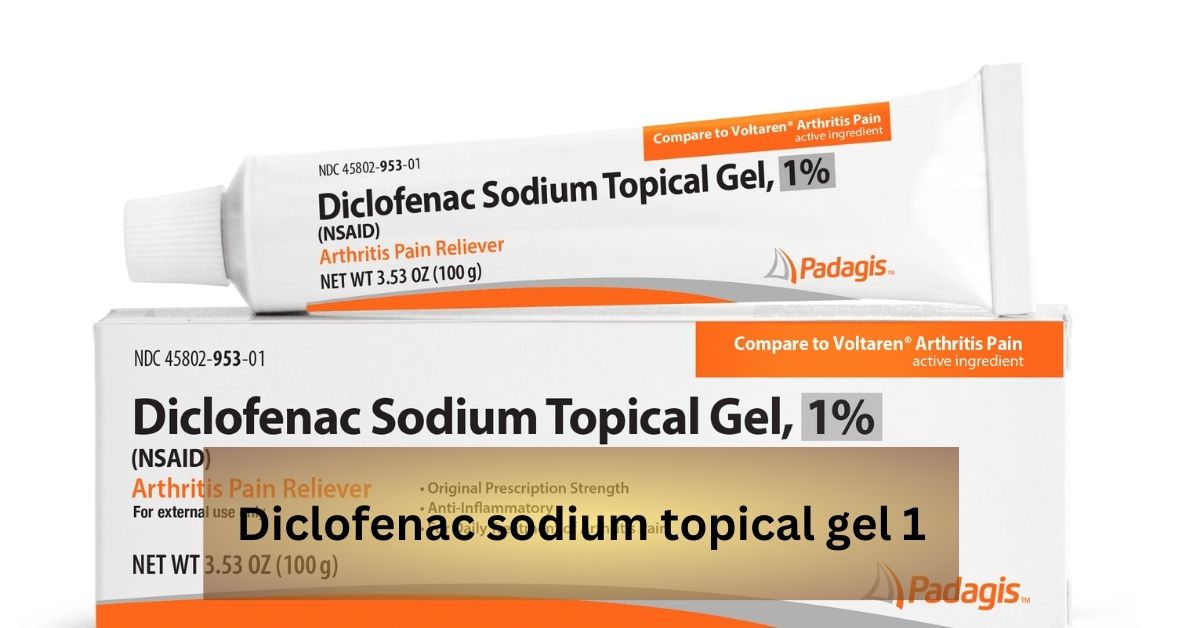In the realm of pain management, where discomfort and aches often disrupt our daily lives, finding effective and user-friendly solutions becomes paramount. One such ally in the battle against pain is Diclofenac Sodium Topical Gel 1%, a topical medication that offers targeted relief for various musculoskeletal conditions.
Let’s delve into the nuances of this gel and explore how it works wonders for those seeking comfort.
Understanding Diclofenac Sodium:
Diclofenac sodium, the active ingredient in this topical gel, belongs to the nonsteroidal anti-inflammatory drug (NSAID) class.
It works by inhibiting the production of certain substances in the body that cause inflammation.
Unlike oral NSAIDs, the gel is applied directly to the skin, allowing for localized relief without affecting the entire body systemically.
Indications and Usage:
Diclofenac Sodium Topical Gel 1% is commonly prescribed for the management of osteoarthritis of the joints, such as the knees and hands.
It is also beneficial for treating acute musculoskeletal injuries, like sprains and strains. The gel is renowned for its efficacy in reducing pain and inflammation associated with these conditions.
How to Use?
One of the notable advantages of this topical gel is its ease of application. Users are advised to apply a thin layer of the gel to the affected area, gently rubbing it into the skin.
The frequency of application depends on the specific condition and severity of symptoms, as directed by a healthcare professional. It is crucial to follow the prescribed dosage and avoid applying the gel to broken or irritated skin.
Targeted Relief:
Unlike oral medications that may take time to circulate throughout the body, Diclofenac Sodium Topical Gel 1% delivers targeted relief directly to the site of pain.
This targeted approach not only enhances the effectiveness of the medication but also minimizes the risk of systemic side effects commonly associated with oral NSAIDs.
Read: How many tbsp in 1/4 cup? – Cooking Essentials
The Biochemistry of Relief:
Unraveling Diclofenac Sodium’s Impact on Inflammation
Embark on a journey through the intricate biochemistry behind Diclofenac Sodium, understanding how its targeted action alleviates inflammation and pain.
Targeting the Epicenter:
A Spotlight on Localized Pain Management with Diclofenac Sodium. Explore the concept of precision in pain relief as we delve into how Diclofenac Sodium Topical Gel 1% delivers targeted benefits to specific areas, sparing the rest of the body from systemic effects.
The Symphony of Ailments:
Diverse Applications of Diclofenac Sodium in Musculoskeletal Health. Survey the vast landscape of musculoskeletal conditions that find solace in Diclofenac Sodium, from chronic arthritis to acute injuries, uncovering the gel’s versatility in addressing diverse challenges.
The Art of Application:
Mastering the Technique for Optimal Diclofenac Sodium Benefits. Break down the application process into a step-by-step guide, empowering users to maximize the effectiveness of Diclofenac Sodium while minimizing the risk of side effects.
Beneath the Surface:
Exploring the Pharmacokinetics of Diclofenac Sodium Absorption
Delve into the scientific intricacies of how Diclofenac Sodium is absorbed through the skin, shedding light on the pharmacokinetics that influence its efficacy.
From Bench to Bedside:
The Evolution of Diclofenac Sodium from Research to Practical Pain Relief
Trace the transformative journey of Diclofenac Sodium from laboratory discovery to a practical, accessible solution for individuals grappling with pain.
Beyond Pain:
Examining Diclofenac Sodium’s Potential Impact on Inflammatory Skin Conditions. Uncover the broader applications of Diclofenac Sodium, exploring its potential role in managing inflammatory skin conditions beyond its traditional musculoskeletal focus.
The Symbiosis of Care:
Integrating Diclofenac Sodium into Comprehensive Pain Management Plans. Discover how Diclofenac Sodium fits seamlessly into holistic pain management strategies, harmonizing with other therapeutic approaches for a well-rounded care plan.
Under the Sun:
Sun Exposure Guidelines and Sun-Smart Practices During Diclofenac Sodium Use. Navigate the nuances of sun exposure while using Diclofenac Sodium, gaining insights into protective measures and sun-smart practices to safeguard your skin.
A Dialog with Experts:
Decoding Healthcare Professional Recommendations for Diclofenac Sodium
Engage in a conversation with healthcare professionals as we unravel their insights and recommendations, shedding light on the collaborative approach to optimizing pain relief with Diclofenac Sodium.
Minimizing Side Effects:
While generally well-tolerated, users should be aware of potential side effects, including skin irritation at the application site. It is advisable to avoid exposure to sunlight on treated areas, as this may increase the risk of skin reactions.
As with any medication, individuals with a history of allergic reactions or other contraindications should consult their healthcare provider before use.
Consultation with Healthcare Professionals:
Before incorporating Diclofenac Sodium Topical Gel 1% into your pain management routine, it is essential to consult with a healthcare professional. They can assess your specific condition, provide personalized recommendations, and ensure that the medication aligns with your overall health profile.
The Tolerability Spectrum: Understanding and Mitigating Potential Side Effects
Explore the various facets of Diclofenac Sodium’s tolerability, examining potential side effects and offering insights into strategies to mitigate and manage them effectively.
By gaining a comprehensive understanding of the tolerability spectrum, users can make informed decisions about incorporating the gel into their pain management routines while prioritizing their overall well-being.
Diclofenac Sodium and Physical Therapy:
A Synergistic Approach to Healing: Uncover the synergies between Diclofenac Sodium Topical Gel 1% and physical therapy, highlighting how the gel can complement and enhance the outcomes of therapeutic exercises.
This exploration delves into the collaborative relationship between localized pain relief and targeted physical interventions, providing a holistic perspective on rehabilitation.
Diclofenac Sodium’s Role in Personalized Pain Management Plans:
Delve into the concept of personalized pain management and understand how healthcare professionals tailor Diclofenac Sodium treatment plans to individual needs.
From considering unique medical histories to adapting dosages, this heading explores the customization of pain relief strategies to maximize efficacy and patient satisfaction.
Read: kevin selleck | Exploring the Life and Career of a Multifaceted Talent
Timelines and Expectations with Diclofenac Sodium
Manage expectations effectively by examining the timelines associated with Diclofenac Sodium’s pain-relieving effects.
From the onset of application to the duration of relief, understanding the temporal aspects empowers users with realistic expectations, fostering a positive and informed experience with the medication.
Diclofenac Sodium’s Environmental Impact
Dive into the ecological considerations surrounding Diclofenac Sodium, shedding light on its environmental impact.
This exploration delves into the sustainability aspects of the gel, examining factors such as production processes, packaging, and disposal practices, encouraging users to make environmentally conscious choices in their pain management journey.
Conclusion:
In the quest for effective pain management, Diclofenac Sodium Topical Gel 1% emerges as a promising solution, offering targeted relief with a user-friendly application.
As with any medication, a collaborative approach with healthcare professionals ensures optimal results. Embrace the power of localized relief and rediscover comfort with this remarkable topical gel.
Read More:



